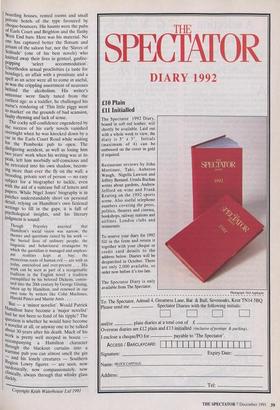And this little pig had too much to drink
Keith Waterhouse
THROUGH A GLASS DARKLY: THE LIFE OF PATRICK HAMILTON by Nigel Jones Scribners, £18.95, pp. 408
o reads Patrick Hamilton these Wh days? J.B. Priestley wrote of him:
He is no great major novelist, taking all society in his grasp, and he never pretended to be. But among the uniquely minor novelists of our age, he is a master.
But who reads Priestley these days?
Remembered, since the war, chiefly for the screen versions of Gaslight and Rope (which he detested) and for his masterly novel Hangover Square, Hamilton has lately been enjoying a limited comeback, with one or two of his novels in paperback, a couple more dramatised, another made into a television series, and now this workmanlike biography. But in the feast of Thirties and Forties literature, he will always be a side dish, dipped into more for
the taste and the flavour than the calorific content.
What happened to Hamilton is succinctly summarised in the title of an affectionate memoir by his brother, The Light Went Out. No stranger to the bottle — a tendency partly inherited from his father, a philandering barrister turned writer (who to the young Patrick's mortification called himself 'the writer and barrister') — he spent longer and longer periods in an alcoholic haze until finally claimed by that arch-enemy of promise, cirrhosis of the liver. Having published his first novel at 21, he produced nothing in the last seven years of his life; his last work, the Gorse trilogy, for all that Graham Greene called The West Pier 'the best novel written about Brighton' (a bit of a backhanded compliment, when you think about it), shows signs not so much of burning the midnight oil as of knocking the lamp over.
Like many another 'minor novelist' (a phrase he must have detested, having been compared in his time with Scott Fitzgerald, Isherwood, Orwell, Sinclair Lewis and Graham Greene), Patrick Hamilton drew largely from life. He lived in a succession of 'I want to thank all those who raised objections and now if there are no further objections why these two should not be joined together, we will proceed with the ceremony.' boarding houses, rented rooms and small private hotels of the type favoured by cheque-bouncers. His haunts were the pubs of Earls Court and Brighton and the flashy West End bars. Here was his material. No one has captured better the flotsam and jetsam of the saloon bar, nor the 'Slaves of Solitude' (one of his best novels) who knitted away their lives in genteel, gasfire-
popping 'select accommodation'. Unorthodox sexual proclivities (a taste for bondage), an affair with a prostitute and a spell as an actor were all to come in useful, as was the crippling assortment of neuroses behind the alcoholism. His writer's antennae were finely tuned from the earliest age: as a toddler, he challenged his nurse's rendering of 'This little piggy went to market' on the grounds of bad scansion, faulty rhyming and lack of sense.
The cocky self-confidence engendered by the success of his early novels vanished overnight when he was knocked down by a car in the Earls Court Road while waiting for the Pembroke pub to open. The disfiguring accident, as well as losing him two Years' work when his writing was at its Peak, left him morbidly self-conscious and he retreated into his own shadow, becom- ing more than ever the fly on the wall, a brooding, private sort of person — no easy subject for a biographer to tackle, even with the aid of a suitcase full of letters and Papers. While Nigel Jones' biography is in Patches understandably short on personal detail, relying on Hamilton's own fictional writings to fill in the gaps, it is full of Psychological insights, and his literary judgment is sound:
Though Priestley asserted that
Hamilton's social vision was narrow, the themes and questions raised by his work
the buried lives of ordinary people; the linguistic and behavioural stratagems by which the quotidian is managed and unpleas-
ant realities kept at bay; the mysterious roots of human evil — are with us today, unresolved and ever-present ... His work can be seen as part of a recognisable tradition in the English novel: a tradition exemplified by his beloved Dickens, contin- ued into the 20th century by George Gissing, taken up by Hamilton, and renewed in our own time by writers like Colin MacInnes, Harold Pinter and Martin Amis But — a 'minor novelist'. Would Patrick Hamilton have become a 'major novelist' had he not been so fond of his tipple? The question is whether he would have become a novelist at all, or anyway one to be talked about 30 years after his death. Much of his Work is pretty well steeped in booze — through a Hamilton character the blackout curtains into a wartime pub you can almost smell the gin and his lonely creatures — Southern Region Lowry figures — are seen, now sardonically, now compassionately, now `2,1inically, always through that whisky glass uarkiy.
Copy right Keith Waterhouse Ltd 1991



























































 Previous page
Previous page